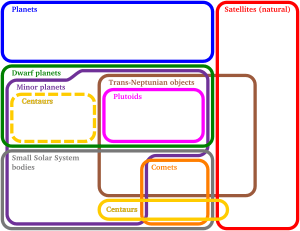Small Solar System body facts for kids

A Small Solar System Body (often called an SSSB) is a space object orbiting our Sun. It is not a planet, a dwarf planet, or a natural satellite (moon). The International Astronomical Union (IAU) first used this term in 2006. They said it includes all objects orbiting the Sun, except for planets, dwarf planets, and moons.
This group includes all comets. It also includes most minor planets. Examples are asteroids (like those in the main asteroid belt). It also covers Trojan asteroids and Centaur objects. Many trans-Neptunian objects are also SSSBs.
Some well-known dwarf planets used to be called minor planets. These include Ceres, Pluto, Haumea, Makemake, and Eris. They are not SSSBs because they are now classified as dwarf planets.
Contents
What Defines a Small Solar System Body?
The definition of SSSBs came about in 2006. This was when the IAU decided what a planet is. That decision also changed Pluto's status to a dwarf planet. So, an SSSB is simply any object orbiting the Sun that is not a planet or a dwarf planet.
This definition does not include objects from outside our Solar System. For example, interstellar objects like 'Oumuamua are not SSSBs. They are just passing through our system.
Scientists are still deciding if there should be a smallest size for SSSBs. Right now, it might include tiny objects like meteoroids. These are the smallest solid objects orbiting the Sun. Even smaller things exist, like cosmic dust and tiny particles. But these are usually not called SSSBs.
SSSBs vs. Moons
natural satellites (moons) are different from SSSBs. The main difference is not their size. It is how they orbit. Moons do not orbit the Sun directly. Instead, they orbit other objects. These can be planets, dwarf planets, or even other SSSBs.
Some very large SSSBs might be reclassified in the future. If they are round because of their own gravity, they could become dwarf planets. Scientists are still studying them.
Where Do We Find Small Solar System Bodies?
Most SSSBs are found in two main areas. One is the asteroid belt. This belt is located between Mars and Jupiter. The other is the Kuiper belt. This belt is found beyond Neptune.
These two belts have some structure. This is due to the gravity of large planets like Jupiter and Neptune. The edges of these belts are not perfectly clear.
Other parts of the Solar System also have SSSBs. These areas have fewer of them. They include:
- near-Earth asteroids: These are asteroids that come close to Earth.
- Centaurs: These objects orbit between Jupiter and Neptune.
- comets: These are icy bodies that can grow tails when they get close to the Sun.
- scattered disc objects: These are icy bodies found beyond the Kuiper belt.
See also
 In Spanish: Cuerpo menor del sistema solar para niños
In Spanish: Cuerpo menor del sistema solar para niños
- Apollo asteroid
- Centaur (small Solar System body)
- Hungaria asteroids
- List of possible dwarf planets
- List of gravitationally rounded objects of the Solar System
- List of Solar System objects by size
- Lists of small Solar System bodies
- List of minor planets and comets visited by spacecraft


